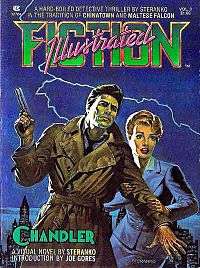Chandler: Red Tide
 Chandler: Red Tide (1976) Painted cover by writer-artist Jim Steranko | |
| Author | Jim Steranko |
|---|---|
| Illustrator | Jim Steranko |
| Cover artist | Jim Steranko |
| Country | United States |
| Language | English |
| Series | Fiction Illustrated Vol. 3 |
| Genre | Graphic Novel, Historical Fiction |
| Publisher | Pyramid Books |
Publication date | 1976 |
| Media type | Print (paperback) |
Chandler: Red Tide is a 1976 illustrated novel, an early form of graphic novel, by writer-artist Jim Steranko.
The digest-sized book combines typeset text with two same-sized illustrations per page, utilizing no word balloons or other traditional comics text conventions. A hard-boiled detective novel in the film noir style, its protagonist is a private detective named Chandler (an homage to author Raymond Chandler) who is hired by a man who claims to have been poisoned by the same people responsible for a notorious gangland slaying. As Chandler tracks down witnesses, each begins to turn up dead.
Publication history

Packaged by Byron Preiss Visual Publications and published by Pyramid Books,[1] under vice-president Norman Goldfind,[2] in 1976, Chandler was written, drawn, and colored by veteran comics creator Jim Steranko. There is an introduction by crime novelist and former San Francisco private detective Joe Gores, and a foreword by Preiss. The original cover price was one dollar.
Preiss said the book was "created to retail at American newsstands alongside hundreds of other paperback offerings".[3] The mass-market edition (ISBN 0-515-04078-9), which Preiss said had a "50,000+ press run", was the third in a series from the publisher, and also known as Fiction Illustrated Vol. 3. (See image at left.) It was supplemented by a separate edition for bookstores that was double the dimensions of the newsstand edition.[3] Steranko, through his company Supergraphics, additionally offered the latter in a limited edition of 750 with a signed and numbered signature plate.[4]
Steranko in 1978 recalled the project's genesis:
Chandler was a fill-in book. That particular number of [the] Fiction Illustrated [series] was to have been Ralph Reese's Sherlock Holmes book [eventually published as Fiction Illustrated #4 — Son of Sherlock Holmes (1977)]. Ralph had worked on it for a year, and Byron realized ... that the book couldn't get out in time. He asked me if I would do a book to replace it. There are two men you never ask to fill in on a late deadline: Neal Adams and myself. We're both overcommitted. Byron's a good friend and I tried to do what I could for him, so I said I would do this book. It was produced in 2½ months where it should have taken at least six months to do. It was my first visual novel, and it was a major project.[5]
He elsewhere said that in creating the book he used golden sectioning, "a mathematical formula to arrange elements in a unified structure, to create an image-to-text relationship that readers would be very comfortable with. The text on any given page related only to that page".[6]
Steranko, who retained rights to the character, was then assigned to create a 12-page "Chandler" story for Penthouse magazine, working with executive editor Art Cooper. When Cooper departed Penthouse, the project was canceled and Steranko was paid a kill fee.[7]
Dark Horse Comics had planned to publish a revised edition of Chandler: Red Tide in December 1999, with revamped and more hardboiled art and text by Steranko,[8] but this did not see fruition. Dark Horse Presents vol. 3, #3 (Aug. 2011) included a 13-page Chapter 1 of Red Tide.[9]
Reception

Chandler: Red Tide did not meet sales expectations, with Steranko recalling in 2003 that, "When the book appeared it was not embraced by the comic-book community because it didn't have word balloons or captions. Believe it or not, they found that shocking!"[6] In 1978, shortly after the book's publication, he said, "I was disappointed in Pyramid's distribution and promotion of it. ... They did a major mailing on it, but there was more that can be done".[5]
Illustrated-novel format
Chandler: Red Tide is similar to Harold Foster's comic strip Prince Valiant in that the narrative is carried by a combination of graphics and text blocks without word balloons. Steranko used the term "graphic novel" in his introduction, though it was labeled "a visual novel" on the cover.
References
- ↑ The back cover reads: "A Pyramid publication produced by Byron Preiss Visual Publications"
- ↑ Ashley, Mike. Gateways to Forever: The Story of the Science-Fiction Magazines, 1970–1980, (Liverpool University Press - Liverpool Science Fiction Texts & Studies, 2007), p.323
- 1 2 Preiss, Byron "Eisner or Steranko? Check the Facts" (op-ed), ComiCon.com: The Pulse, July 22, 2003. WebCitation archive.
- ↑ "[Advertisement]". Mediascene (17). January–February 1976. p. 10.
And available exclusively from Supergraphics is the special bookplate edition, limited to 750 copies. This edition is distinguished by a unique illustrated bookplate, which will be personally numbered and autographed by Steranko, Chandler's award-winning artist and writer.
- 1 2 Burchett and Mantels, p. 12
- 1 2 Archive of Epstein, Daniel Robert, "The First Graphic Novel? Steranko's Take" at the Wayback Machine (archived December 24, 2005), Newsarama, July 14, 2003.
- ↑ Burchett, Rick, and Ed. Mantels, "Whizzard Talks to Steranko", Whizzard vol. 2, #11 [issue #16] (Summer 1978; published by Marty Klug, 5730 Chatport Road, St. Louis, Missouri), p. 13
- ↑ Smith, Kevin Burton. "Chandler", ThrillingDetective.com, n.d. WebCitation archive.
- ↑ Dark Horse Presents vol. 3, #3 at the Grand Comics Database
External links
- The Drawings of Steranko: '"Red Tide (fan site)